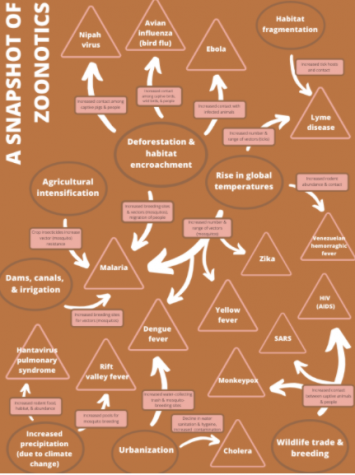Blaming the right beast: why the pandemic is humanity’s fault
When humans disturb the ecosystem, the consequences come back to bite us — in the form of viruses like COVID-19.
September 25, 2020
Eight years ago, a science writer named David Quammen predicted the COVID-19 pandemic.
In his bestselling book Spillover: Animal Infections and the Next Human Pandemic, Quammen wrote:
“If there is a Next Big One it will be zoonotic. Certain kinds of viruses [are the] likeliest candidates to cause a new pandemic… coronaviruses in particular.”
It wasn’t the supernatural prediction of a fortune-teller; nobody could have known the exact details of the 2020 breakout. It wasn’t random or psychic. Quammen’s prescience was derived from the vigorous research of hundreds of scientists. It was the compilation of daring expeditions and long hours in the lab and truckloads of evidence. It was scientifically solid and inevitable.
A wet market in China. It’s where the pandemic likely originated, from a bat, a civet, or a pangolin. But despite President Donald Trump’s claims, COVID-19 is not a uniquely Chinese virus, and the transaction of viruses from animal to human is not a uniquely Chinese phenomenon. It’s a spillover that can occur, probably does occur, and has occurred with drastic consequence, all over the world. A tourist feeds a monkey at a Hindu temple; a tourist visits a cave in Uganda. A man butchers a chimpanzee in Cameroon; the disease enters another man’s bloodstream after sexual intercourse, hundreds of miles away.
Mankind encroaches on wild habitat year after year, snipping off bits and pieces, sometimes slowly to escape perception, sometimes rapidly to ensure profit. And it comes back to bite him in the butt.
Spillover was published in 2012, and its predictions were eerily accurate. Tracing the zoonotic episodes of Nipah, Ebola, Marburg, and even AIDS, among other diseases, Spillover pounded the evidence into one clear, bold, daunting statement: we will have another pandemic. And it will be because of us.
The rest of the world was slow to react.
THE WEB
Interactions between humans and wildlife form a fragile web. At times it is brittle, snappable, and at times it is supple and resilient. But it is always delicate. Each of us holds a thread in that web; when we tug, the whole thing threatens to collapse.
Something we often forget— often don’t even realize— is that humans and animals are intricately, hopelessly, perplexingly tangled. We say this all the time, but it’s possible none of us really know how deep the implications run. The tourist whose finger brushed against guano, the first man to encounter simian immunodeficiency virus (SIV), the Cameroonian chimpanzee that would unleash AIDS, the man who killed the civet (or bat or pangolin) that was sold in a market that was served at a restaurant— they were threads. They were threads that tugged, and the fabric of the world trembled.
Zoonotic diseases are an intersection. It’s not a four-way crossing; it’s more of a monstrous, fifty-way intersection with cars driving in the wrong lanes and spilling onto the crosswalks. Zoonotic diseases— viruses or bacteria which are passed from animals to human beings— account for many of the most notorious outbreaks we know today: Marburg, Ebola, Nipah, SARS, rabies, malaria, bird flu, Lyme disease, Q fever, and AIDS. All the influenza viruses are zoonotic as well.
(Quammen’s book dives fantastically in-depth into all of these diseases. As a National Geographic reporter and author, he writes with a vigor that rightly amplifies scientific research as exploration.)
So there are four points we need to try to understand and digest to get to the root of COVID-19:
- Many viruses are zoonotic.
60% of known infectious diseases are zoonotic. The Spanish Flu of 1918 and the Black Death in the 14th century were zoonotic. Rodents, bats, and primates account for the source of 75% of all viruses that we know of.
The animal species from which the virus originates is called the reservoir host.
- Viruses (although their aliveness is debated) are like any other organism: they want to succeed and replicate.
Viruses cannot replicate unless inside a living organism’s body. They have evolved for billions of years alongside specific species. One virus is adapted to a specific animal’s bodily conditions, and likewise, that animal is adapted to the specific virus living inside it so that it doesn’t get sick. It’s an ecological balance struck after slipping and sliding off the evolutionary tightrope for years. The virus succeeds and reproduces within its reservoir host, and the reservoir host lives out its life not knowing any better.
If, or when, an unfamiliar species bumbles into the area, offering a new bodily bonanza for viruses to replicate in, a virus can make the leap. Viruses are constantly mutating, for better or for worse, and a mutation may arise which can adapt to the human body.
- There are many ways for human beings to bumble into contact with a zoonotic virus.
The first such method of conception is obvious: by consumption. Stomach acids are strong enough to dissolve viruses, but if you have a cut in your mouth, or a droplet of blood enters a cut on your finger while you hack up bushmeat, you can end up infected.
Viruses enter through openings.
- Habitat encroachment and lack of biodiversity increase the chances of a spillover.
This is not a minimal increase; this is significant and perhaps the most important point. As you’ll see, it’s not just the consumption of wild animals in a wet market that exposes us to viruses; rather, it’s the cumulative effect of human beings as we live, buy, sell, want, regret, destroy, replant, rebuild, and adapt the earth to our daily demands.

the Convention on Biological Diversity. (Eva Shen)
A SPILLOVER IN CONNECTICUT
You are a virus, living happily inside of a white-footed mouse, who in turn, lives in the picturesque woodlands of Connecticut. The forest isn’t exactly a fairytale for the mouse: there are hawks, foxes, snakes, bobcats, weasels, and opossums. All are hungry. Recently, however, there’s been less predatory activity. The mouse has been able to mate successfully and breed a new litter. It is nearly as happy as you are.
You’re swimming in the mouse’s blood when out of nowhere a tick latches onto its ear, where it’s soft and the mouse can’t reach to groom itself. The tick slurps up blood— expanding from pinprick to pinhead sized— and you are sucked into the new body. It’s smaller than the mouse’s, but that doesn’t make a difference to you. You begin replicating once again.
The tick, however, isn’t satisfied. It drops off the mouse’s ear and latches on to a passing deer. The deer is larger and holds vast numbers of ticks— up to 1000— and here, your tick host finds a mate. The female tick will lay thousands of eggs in the spring.
But the tick isn’t done yet. A human walks by through the grass, pant cuffs rolled up. The tick, ever the opportunist, sinks into human skin. As it guzzles blood, you swim into the human’s leg.
You are Borrelia burgdorferi, the bacterium which causes Lyme disease.
The first case of Lyme disease was diagnosed in 1975 in Lyme, Connecticut. The spillover was caused by a variety of factors. Each interconnected, each stemming from a parent thread: biodiversity.
The decline of predatory species, like hawks, and competitive species, like chipmunks, allowed for a boom in the mouse population. (This happens everywhere where biodiversity decreases— the little primary consumers receive a boost). The abundance of white-footed mice meant an abundance of ticks, which meant an abundance of opportunities for Borrelia burgdorferi to enter human beings. So it did.
Now, 30,000 cases of Lyme disease are reported to the CDC each year. This number doesn’t include unreported cases, and it is estimated that 300,000 people overall are infected with Lyme disease in the U.S. each year.
Habitat alteration— in the form of land conversion, oil extraction, mining, deforestation, wetland drainage, dam construction, pesticides and antimicrobials, agriculture, climate change, etcetera, etcetera, etcetera— reduces biodiversity. It “alter[s] species distribution, abundance, movement, [and] interactions with other species” and allows for “accidental or intentional human introduction of species,” according to the World Health Organization (WHO). Habitat destruction has been “identified as the leading driver of emerging infectious diseases.”
The consequences are literally fatal.
That’s the thing with human beings: we go where we’re not supposed to. On some level that’s forgivable. All animals are born with an innate curiosity, it’s what drives us to survive, to explore the land and find new resources. The problem with humans is that our curiosity to seek resources has morphed into a hunger to exploit them.
If you think about the (incomplete) list above, of the many ways humans alter the landscape, you might begin to grasp the complexity of the web. All the threads are somehow knotted together and it all twists together into one giant, ugly snarl.
The only thing we can be sure of is that our individual threads are in there somewhere, bound to the web by the products we use, the ways we travel, the foods we eat, the foods we waste, etcetera, etcetera, etcetera.
COVID-19 IMPLICATIONS
COVID-19 is a coronavirus, like the infamous SARS (severe acute respiratory syndrome) and MERS (Middle East Respiratory Syndrome). SARS first occurred in 2002 in Guangdong, China and went on to infect 8096 people in a global panic. Its reservoir host is suspected to be masked palm civets or bats. MERS was first reported in Saudi Arabia and seems to have traveled to humans from bats through camels.
Like its cousins, COVID-19 has been confirmed as a zoonotic virus. The suspected reservoir host: horseshoe bats. The virus likely passed from a bat to another animal— a civet, a pangolin— in a harmless, natural encounter. Then the animal was poached, shipped to a wet market, bought and sold and interacted with.
The implications are obvious. Besides being unnecessary and oftentimes unethical, the wildlife trade can be dangerous. Intrusion comes with a price.
In ecology, the term outbreak does not refer to disease. An outbreak is when a species’ population density skyrockets, then falls back to relatively zero after a period of time. Locusts are an outbreak species. Every few years, eruptions of locusts overwhelm Africa, damaging crops and livelihoods. Lemmings, too: they can disappear for decades before overflowing the tundra. Outbreaks occur in cycles, called boom-and-bust cycles.
Quammen brings up an interesting— and very telling— point in his book. Humans are an outbreak species. We underwent a drastic, unmistakable boom during the Industrial Revolution, when our population exploded exponentially. We are the ultimate outbreak species. We pop up everywhere.
So when does it end? We’ve undergone our boom, but so far not the bust. Outbreaks ALWAYS come to an end— it’s in the definition— and for a species as abundant, ubiquitous, and truly unstoppable as Homo sapiens, the most likely end comes in the form of viruses. That’s why global pandemics are such a threat. They have been fated as humanity’s doom.
BLAMING THE RIGHT BEAST
It can be easy to blame wild animals for our diseases.
Particularly bats. They have been implicated as the reservoir hosts of a disproportionate number of zoonotics— including SARS, Marburg, and Ebola— due to a variety of factors. A new University of California, Berkeley, study found that bats have hardy immune systems that far outpace ours. This “drives viruses to replicate faster, so that when they jump to mammals with average immune systems, such as humans, the viruses wreak deadly havoc.”
So it isn’t that bats carry more viruses; they just carry more potent viruses, to no fault of their own. Evolution couldn’t have picked a more efficient transmitter: bats are abundant and widespread, they roost in colonies and migrate with the seasons. They’ve evolved with viruses over a long, deep history.
But it would be insensible, misinformed, and irresponsible to condemn bats— or any other reservoir species— for our own abundance, urbanization, patternless migration, and environmental destruction. Human intrusion into specially-crafted evolutionary partnerships almost invites zoonotics to infect us.
Think of the vastness of the Amazon Rainforest. For almost all of history it has lain impenetrable to human beings, a jungle full of bizarre and wonderful creatures almost certainly circulating with zoonotic diseases. All the players are hovering in an evolutionarily-balanced equilibrium— until humans plunge in with bulldozers, disturbing the ecosystem through deforestation and exposing our own vulnerabilities.
Some people may want to do away with reservoir species altogether. No reservoir, no virus. The thing is, reservoir species are difficult to determine and pinpoint. Even when identified, completely eliminating a reservoir species nears on impossible. It also holds the potential of wreaking further havoc on the environment and unleashing new zoonotics. If there’s anything that COVID-19 has taught us, it’s that our interference with wilderness provokes unintended consequences.
“We’ve been stuck in our homes for just one month so far, and already – in the absence of our daily activities – nature is rebounding,” Dr. Amy Levine, director of field conservation programs at the Denver Zoo, said. “If this isn’t evidence that every one of our seemingly insignificant choices and behaviors can have monumental global impact, I don’t know what is.”
Maybe just reread that quote right now and think about it a little.
So as human beings, we accept the blame. And then what? We sit within our four walls and wait it out? Pray we don’t get infected and that it never happens again?
The WWF highlights five action items necessary to prevent future pandemics, roughly paraphrased below:
1. Eliminate high-risk wildlife trade and markets.
2. Address environmental change and habitat loss, including deforestation.
3. Improve the management of livestock to reduce zoonotic disease transmission into agricultural and food systems.
4. Ensure that the dietary needs of the rural poor are safely met, especially where communities rely on wild species for protein.
5. Eliminate demand for and consumption of high-risk wildlife.
On an individual level, it all circles back to sustainability, as it often does. Sustainability is at the root of every problem and every solution. Remember: we are not just doing this for our own good. Billions of creatures rely on us. At the same time, we are doing this for our own good. We are part of these billions, too.
David Quammen, meanwhile, has been enlisted by Simon & Schuster to write a book on the COVID-19 pandemic. He’s published two articles on it already: one on the U.S’s response to the pandemic, and one on how humans made the coronavirus epidemic. As he so succinctly writes: “We disrupt ecosystems, and we shake viruses loose from their natural hosts. When that happens, they need a new host. Often, we are it.”
In the end, it’s about the web. As Quammen highlights in Spillover, “People and gorillas, horses and duikers and pigs, monkeys and chimps and bats and viruses: We’re all in this together.”



